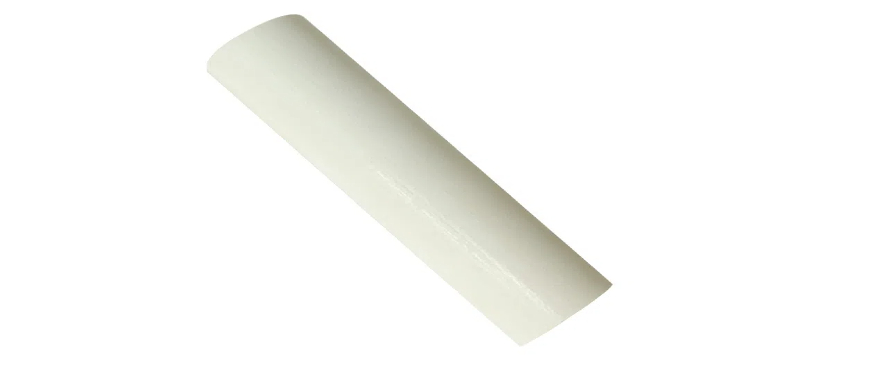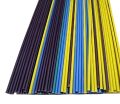
When considering fiberglass rod vs tube vs steel, it’s essential to understand the unique properties of each material. Fiberglass rods are known for their flexibility and strength, making them ideal for applications that require bending without breaking, such as in fishing rods or DIY projects. Fiberglass tubes, on the other hand, are often used for structural support and reinforcement because they offer high tensile strength and resistance to bending. Steel, while extremely strong and durable, is significantly heavier and less flexible than fiberglass, making it better suited for heavy-duty construction but less ideal for applications requiring flexibility. The choice between fiberglass rod vs tube vs steel ultimately depends on the specific needs of the project, including factors like weight, strength, and flexibility. In cost-effective applications, fiberglass often provides a more balanced performance compared to the more rigid steel or the more lightweight yet flexible fiberglass tube.
Fiberglass Rod vs Tube: Exploring the Performance, Cost, and Applications
When it comes to choosing between fiberglass rod vs tube, understanding the performance characteristics, cost differences, and specific applications is essential for making the right choice. Both materials have been favored by enthusiasts, professionals, and hobbyists across various industries due to their versatility and unique properties. While fiberglass rods and tubes share some common features, each offers distinct advantages that make them suitable for different purposes. In this detailed exploration, we will delve into these differences and discuss how both materials hold up in terms of strength, durability, and affordability.
| Property | Fiberglass Rods | Fiberglass Tubes |
|---|---|---|
| Strength | High tensile strength, ideal for load-bearing applications | Lower tensile strength, better suited for flexible uses |
| Flexibility | Rigid, not suitable for applications requiring bending | Flexible, can bend without breaking |
| Load-Bearing Capacity | Excellent, often used for reinforcement and structural support | Lower capacity, better for applications where bending is required |
| Common Applications | Concrete reinforcement, structural support in buildings, bridges, mechanical components | Sporting goods (fishing poles, tent poles), antennas, masts, lightweight structures |
| Environmental Resistance | Highly resistant to UV, moisture, and corrosion | Also resistant to UV, moisture, and corrosion, but with less load-bearing ability |
| Weight | Heavier compared to tubes | Lighter, making them ideal for portable or lightweight applications |
| Durability | Highly durable, ideal for static, heavy-duty applications | Durable, but more suited to dynamic environments requiring flexibility |
| Cost | Generally more affordable due to simpler manufacturing process | More expensive due to additional manufacturing steps (extrusion/pultrusion) |
Durability of Fiberglass Rod vs Tube: Which One Lasts Longer?
Durability is a significant consideration when choosing between fiberglass rod vs tube, as both are often used in harsh environments. Fiberglass rods are solid, which enhances their ability to resist wear and tear over time. They perform well under pressure, offering superior load-bearing capabilities, and can endure extreme conditions without losing structural integrity. This makes them the go-to choice for heavy-duty applications like reinforcement bars in construction or high-performance components in mechanical engineering.
Fiberglass tubes, while still highly durable, may not be as resistant to extreme loads as rods. The hollow core of the tube makes it more susceptible to bending or deformation under heavy pressure. However, they remain highly resilient to environmental stress, offering excellent resistance to corrosion, UV degradation, and impact damage. In applications where flexibility is important, such as poles for tents or fishing rods, fiberglass tubes offer a long-lasting solution without compromising on strength.
In terms of overall durability, fiberglass rods have the edge when it comes to load-bearing and structural applications. However, fiberglass tubes are durable in their own right, especially for applications that benefit from their lightweight and flexible design.
The Cost of Fiberglass Rod vs Tube: Is One More Affordable?
Cost is often a deciding factor when choosing between fiberglass rod vs tube, particularly for budget-conscious consumers. Fiberglass rods are typically more affordable than fiberglass tubes due to the manufacturing process. Creating a solid rod is simpler and requires fewer steps compared to producing a hollow tube. As a result, fiberglass rods tend to be less expensive and are often the material of choice for applications where cost is a primary concern.
Fiberglass tubes, however, are generally more expensive due to the additional manufacturing techniques required to form the hollow structure. Tubes are often extruded or pultruded, processes that require more specialized equipment and additional time, contributing to their higher cost. Despite their increased price, fiberglass tubes are still more affordable compared to high-performance materials like carbon fiber or aluminum, making them an attractive option for applications that require a balance of affordability, flexibility, and durability.
While fiberglass rods are more affordable, fiberglass tubes provide better value in certain applications, such as lightweight structures or products that require bending flexibility. When comparing fiberglass rod vs tube, it’s important to consider the specific demands of your project and whether the added cost of fiberglass tubes is justified by their unique properties.
Applications of Fiberglass Rod vs Tube: What Are They Used For?
The choice between fiberglass rod vs tube depends largely on the specific requirements of your project or application. Fiberglass rods are used in a wide range of applications where strength, rigidity, and load-bearing capacity are essential. Some common uses of fiberglass rods include reinforcement bars in concrete, structural support in buildings and bridges, and mechanical components in industries like automotive manufacturing. Their solid structure makes them ideal for applications where bending or flexing is not required.
Fiberglass tubes, on the other hand, are frequently used in applications where flexibility and lightweight properties are critical. Fiberglass tubes are commonly used in sporting goods, including fishing poles, tent poles, and masts for flags and antennas. The hollow structure of the tube allows it to absorb external stress by bending, making it perfect for dynamic applications that require flexibility without compromising strength.
Additionally, fiberglass tubes are widely used in outdoor equipment, including scaffolding and frame structures, where the need for lightweight yet durable components is crucial. The use of fiberglass tubes in the marine industry, particularly in the manufacturing of boat masts and poles, is also common due to their resistance to corrosion and weathering.
Fiberglass Rod vs Tube: Which Material is Best for Your Needs?
When deciding between fiberglass rod vs tube, it’s essential to consider your project’s specific needs. If you need a material that can withstand heavy loads and provide structural integrity, fiberglass rods are likely the better choice. They are designed to provide strong, rigid support, and are ideal for reinforcement in construction, mechanical applications, or any situation that requires static load-bearing capabilities.
Fiberglass tubes are better suited for applications where flexibility, weight reduction, and resistance to bending are important. Their hollow structure allows them to absorb dynamic forces, making them an excellent choice for products like fishing rods, tent poles, and flagpoles. Tubes also offer advantages in applications where lightweight and corrosion-resistant materials are essential, such as in marine environments or outdoor gear.
Ultimately, both fiberglass rods and tubes are highly versatile materials, and the best choice depends on the specific demands of your project. If strength and rigidity are the priority, fiberglass rods are likely to be the ideal material. If flexibility, weight reduction, and dynamic performance are needed, fiberglass tubes offer unique advantages.
The Future of Fiberglass Rod vs Tube: What Are the Trends?
As technology continues to evolve, so too do the manufacturing processes and applications of fiberglass rod vs tube. New innovations in fiberglass production, including more efficient extrusion and pultrusion techniques, may result in lower production costs and improved material properties. This could lead to more affordable and higher-performing fiberglass rods and tubes for a wider range of applications.
Additionally, engineers are exploring ways to integrate fiberglass rods and tubes with other advanced materials to enhance performance. For example, combining fiberglass with carbon fiber could create a composite material that provides even greater strength-to-weight ratios and flexibility. This could open up new possibilities for industries such as aerospace, automotive, and sports equipment manufacturing.
As the demand for lightweight, durable materials continues to rise, fiberglass rods and tubes will likely remain a popular choice for a wide variety of applications. Whether for structural reinforcement, lightweight poles, or dynamic equipment, fiberglass materials are likely to play a significant role in future innovations.
How About Fiberglass Rod vs Tube: Choosing the Right Option for Your Project
In choosing between fiberglass rod vs tube, it is important to assess the specific performance characteristics that are most relevant to your project. Fiberglass rods offer exceptional strength and rigidity, making them ideal for static, load-bearing applications where bending is not a concern. On the other hand, fiberglass tubes offer the advantage of flexibility and lightweight properties, making them suitable for dynamic applications where the material needs to bend under stress without losing strength.
Consider the weight, load requirements, and flexibility of your application to determine the best material for your needs. Whether you opt for fiberglass rods or tubes, both materials provide excellent durability, resistance to the elements, and affordability compared to alternative materials like carbon fiber or steel. By understanding the key differences between fiberglass rod vs tube, you can make an informed decision that best suits the demands of your project.
Fiberglass Euro Nymphing Rod: A Versatile Fishing Choice
Fiberglass Rod vs Tube: Exploring Benefits, Drawbacks, and Applications
Choosing between fiberglass rod vs tube depends on the specific requirements of the project. Each material brings unique advantages and some limitations, which make them suitable for different purposes. By breaking down the benefits, drawbacks, examples, and applications of fiberglass rods and tubes, we can better understand how to utilize them effectively.
Benefits of Fiberglass Rods
- Exceptional Strength: Fiberglass rods provide unmatched tensile strength due to their solid construction. This makes them highly suitable for load-bearing applications like structural reinforcements and industrial frameworks.
- Resistance to Corrosion: Fiberglass rods excel in environments exposed to chemicals, moisture, or saline conditions, making them ideal for marine and outdoor applications.
- Durability Under Pressure: The solid design ensures fiberglass rods can withstand heavy compression forces, extending their lifespan in demanding applications.
- Cost-Effectiveness: Their straightforward manufacturing process makes fiberglass rods more affordable than many alternatives, especially in bulk.
- Thermal Stability: Fiberglass rods resist high temperatures, which makes them reliable in industrial settings with variable heat exposure.
Benefits of Fiberglass Tubes
- Lightweight Design: The hollow nature of fiberglass tubes reduces their weight, which is beneficial in applications like antennas, masts, and lightweight poles.
- Enhanced Flexibility: Fiberglass tubes can bend without cracking, making them suitable for dynamic uses like fishing poles or tent structures.
- Resistance to Deformation: They handle bending stress well, especially when subjected to repetitive forces in applications such as sports equipment.
- Versatility in Applications: Fiberglass tubes are preferred in projects that require a combination of lightweight and moderate strength.
- Weatherproof Properties: Their resistance to UV radiation and moisture ensures longevity in outdoor environments.
Drawbacks of Fiberglass Rods
- Heavier Weight: The solid construction of fiberglass rods can add unnecessary weight to applications requiring mobility or flexibility.
- Reduced Flexibility: Fiberglass rods lack the ability to bend under stress, which limits their use in dynamic or flexible applications.
- Higher Material Usage: Solid rods require more raw material, which can lead to inefficiency in designs needing minimal weight.
Drawbacks of Fiberglass Tubes
- Lower Load-Bearing Capacity: The hollow structure makes fiberglass tubes less suitable for applications involving significant compression or impact forces.
- Susceptibility to Crushing: Under heavy mechanical stress, fiberglass tubes are more likely to deform compared to solid rods.
- Higher Production Cost: The manufacturing processes required to create hollow tubes, such as pultrusion, can increase costs.
Examples of Fiberglass Rod Applications
- Construction Reinforcement: Fiberglass rods are widely used as rebar substitutes to reinforce concrete in bridges, buildings, and roads due to their high tensile strength and corrosion resistance.
- Industrial Tools: They serve as durable shafts and levers in machinery where strength and reliability are critical.
- LARP and Recreational Uses: Fiberglass rods act as solid cores for safe, durable weapons in live-action role-playing games.
Examples of Fiberglass Tube Applications
- Fishing Poles: The flexibility and lightweight nature of fiberglass tubes make them ideal for crafting fishing rods that withstand repetitive bending.
- Antenna Masts: In communication infrastructure, fiberglass antenna tubes are often utilized due to their lightweight nature and resistance to corrosion. These tubes offer a reliable solution for antenna masts, ensuring longevity and performance in various outdoor environments.
- Marine Equipment: Their weatherproof properties make fiberglass tubes suitable for boat masts and other marine applications.
How to Choose the Best Fiberglass Rods for Billboards Today
Research and Case Studies on Fiberglass Rod vs Tube
Research on Corrosion Resistance
Studies have consistently shown that both fiberglass rods and tubes outperform steel and aluminum in terms of resistance to environmental corrosion. However, rods demonstrate slightly higher durability under long-term exposure to saline environments due to their solid structure.
Case Study in Construction
A construction project utilized fiberglass rods to replace traditional steel rebar in a coastal bridge. The rods offered enhanced durability and eliminated the risk of corrosion from saltwater exposure, resulting in lower maintenance costs over 20 years.
Sports Equipment Innovations
Recent advancements in sports technology have seen fiberglass tubes replacing carbon fiber in mid-range fishing poles. While carbon fiber provides greater stiffness, fiberglass tubes offer a more affordable alternative with sufficient flexibility for amateur sports enthusiasts.
Choosing between fiberglass rod vs tube depends on balancing flexibility, weight, and strength requirements. Fiberglass rods shine in static, load-heavy environments, while fiberglass tubes dominate dynamic, lightweight applications. By understanding these benefits, drawbacks, and examples, you can determine which material suits your project best.
Why Fiberglass Rods for Ground Blinds Are Essential
FAQs about Fiberglass Rod Vs Tube
Fiberglass rods are often considered a better option for many applications due to their combination of durability, flexibility, and cost-effectiveness. Unlike other materials, such as carbon fiber or graphite, fiberglass rods are highly impact-resistant and less likely to snap or crack under stress. This makes them ideal for environments where resilience is crucial. Fiberglass rods also offer a high level of flexibility, allowing them to bend without breaking, which is particularly beneficial in applications like fishing or LARP weapon crafting. Additionally, fiberglass is more affordable than other high-performance materials, making it accessible for both hobbyists and professionals. Their resistance to corrosion and harsh weather conditions further contributes to their longevity, ensuring that fiberglass rods provide excellent value over time. Overall, the superior strength-to-weight ratio and affordability make fiberglass rods a top choice for many practical uses.
The primary difference between carbon fiber rods and tubes lies in their form and intended applications. A carbon fiber rod is typically a solid, cylindrical piece used in various structural, automotive, and recreational applications. Its strength-to-weight ratio makes it ideal for high-performance uses like fishing rods, aerospace components, and sports equipment. On the other hand, a carbon fiber tube has a hollow core, which makes it lighter while maintaining strength. This structural difference gives carbon fiber tubes added flexibility, which is crucial for use in items like scaffolding, lightweight frameworks, and even in the construction of high-performance boats or drones. Both forms leverage the high tensile strength and rigidity of carbon fiber, but while the rod is favored for its solid durability, the tube offers more versatility in applications requiring lightweight and flexible structures.
Whether fiberglass rods are better than graphite depends largely on the specific application. Fiberglass rods are generally considered better for applications requiring durability, impact resistance, and flexibility. For instance, fiberglass is an excellent choice for fishing rods used in rugged conditions or for crafting weapons for LARP, as it is less prone to breaking under stress and can handle rougher usage. Fiberglass also offers a more affordable option compared to graphite. However, graphite rods tend to be lighter and more sensitive, offering greater precision and performance for activities like professional fishing, where sensitivity to light bites is essential. The choice between fiberglass and graphite often comes down to the intended use: fiberglass is better for strength and versatility, while graphite excels in performance and lightweight applications.


